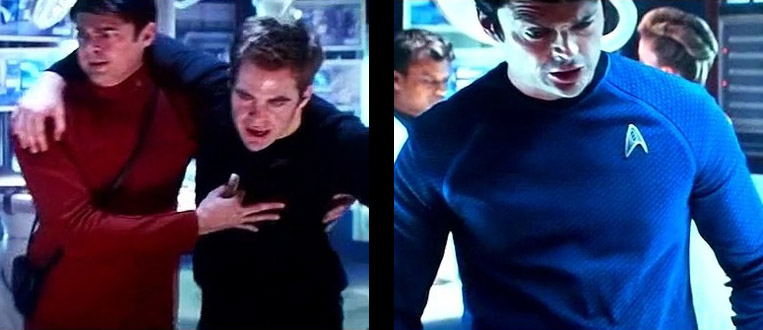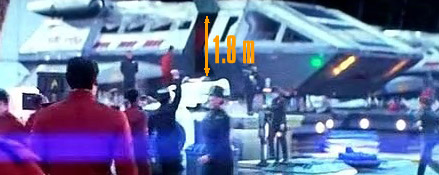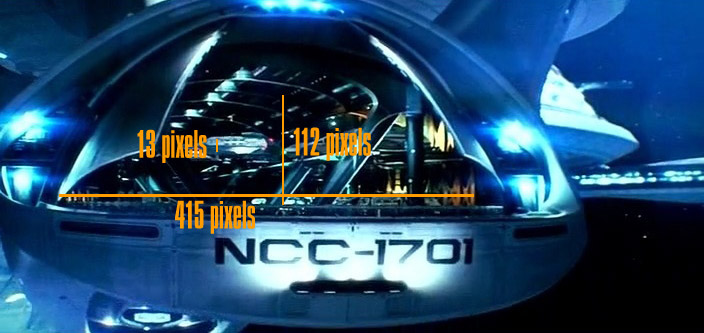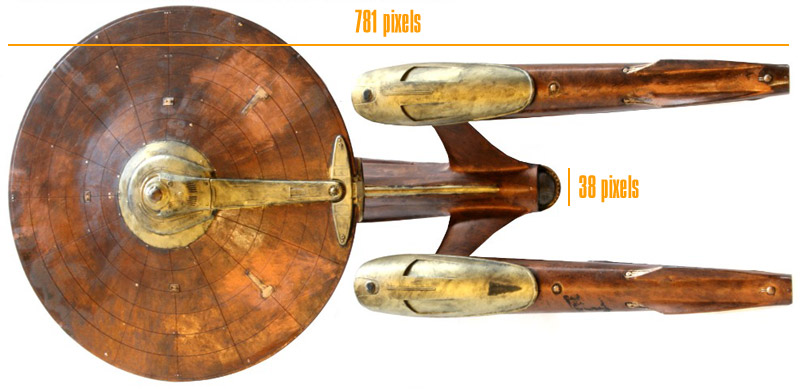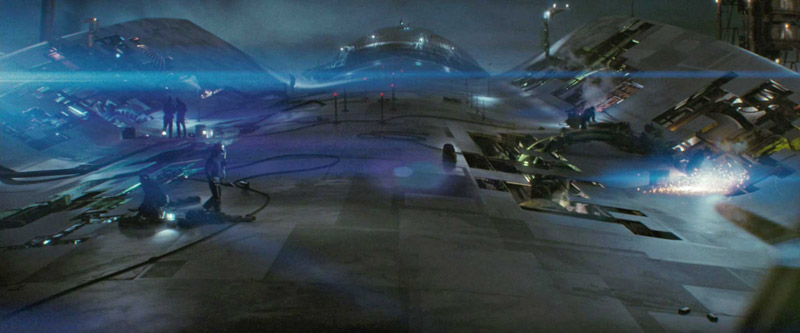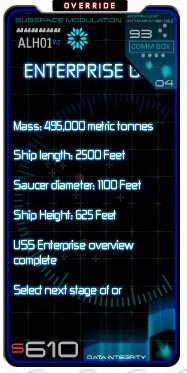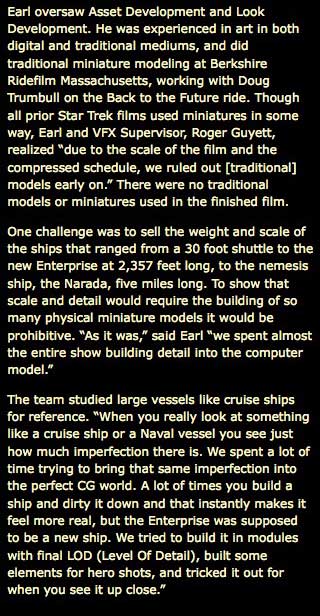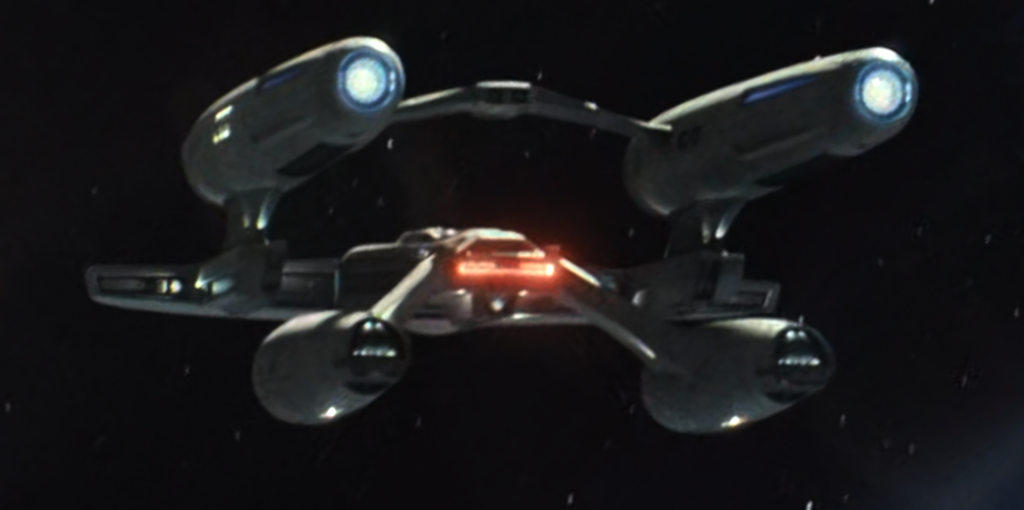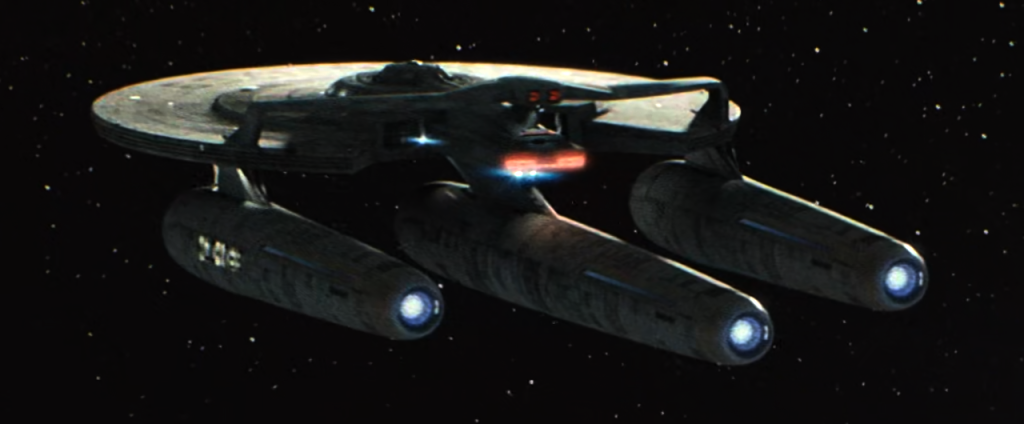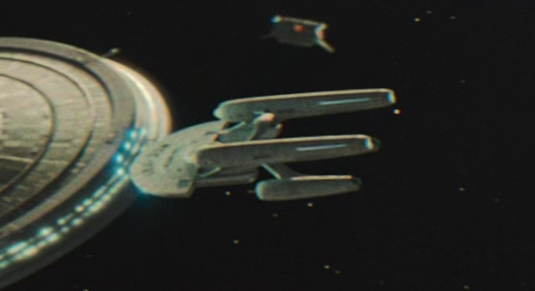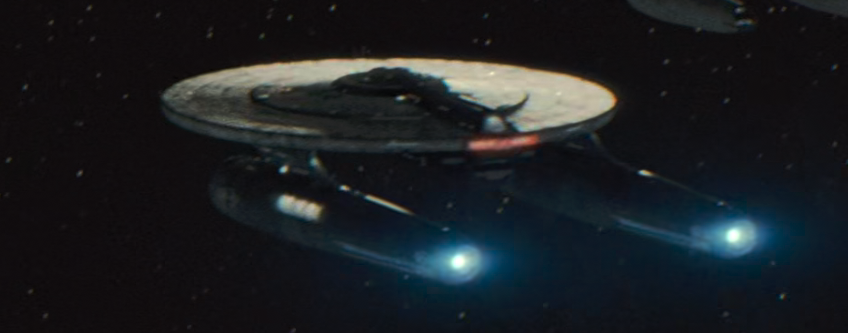This article will cover general issues and questions concerning the latest Star Trek movie.
One of the significant issues raised by Trek XI is just how fast the Enterprise is. Much of this stems from the apparent rapidity of the trip to Vulcan; shortly after the trip begins, Chekov announces to the crew that they are three minutes from Vulcan. So... did the trip really take so little time? Well... not quite.
First let's see what Chekov says :
| Chekov : | "May I have your attention please. At twenty two hundred hours telemetry detected an anomaly in the Neutral Zone, what appeared to be a 'lightning storm in space'. Soon after Starfleet received a distress signal from the Vulcan high command, that their planet was experiencing seismic activity. Our mission is to assess the condition of Vulcan and assist in evacuations if necessary. We should be arriving at Vulcan within three minutes. Thank you for your time." |
This speech prompts Kirk to run off to talk to Uhura, then race to the bridge and talk to Pike just as they arrive at Vulcan. Conclusion? Chekov did indeed state that it would take three minutes to reach Vulcan, and it then did indeed take that long to do so.
However. Chekov does NOT make this speech at the very beginning of the ship's journey. The sequence of events is this :
- Kirk boards the ship, ill from the vaccine McCoy gave him.
The ship departs after a funny Sulu moment where he can't get the warp drive going. - McCoy leads the ill Kirk into sickbay. McCoy injects Kirk with a "mild sedative", and he drops off asleep.
- We cut to the bridge. Sulu reports "engines at maximum warp captain". Pike thanks him and orders Chekov to make his report.
So the question is, how long was Kirk asleep? On the one hand, it is a "mild sedative". And the ship has, apparently, only just got to maximum warp; surely that can't take too long! On the other... Kirk's hands have enough time to blow up to twice their normal size in reaction to the vaccine. And notice McCoy's uniform; he has enough time to change from a red cadet uniform to a blue uniform shirt.
Can we really suppose that the ship takes days to reach maximum warp? It's conceivable. There's no law that says a ship has to be capable of reaching maximum warp in a certain number of minutes or hours. And for that matter, Sulu simply reports that the engines are AT maximum warp. He does NOT say that they have just reached it. He might possibly simply be giving an hourly status report.
So, with a closer look, it is possible that the ship took hours, even days to reach Vulcan. The limiting factor has now become not Chekov's three minute warning, but rather how long we can credibly believe it takes the Enterprise to reach top speed.
However. When we look closer still, things go the other way again.
When Kirk is convincing Pike that Vulcan is actually under attack, listen to what Kirk says about the situation :
| Kirk : | "The Kelvin attack took place on the edge of Klingon space and at twenty three hundred hours last night there was an attack. Forty seven Klingon warbirds destroyed by Romulans sir, and it was reported that the Romulans were in one ship, one massive ship." |
So now we have another solid data point - Uhura's mention of the distress call she picked up. Kirk overheard this whilst he was in bed with her roommate, Gaila. He then took the Kobaysshi Maru test... AND had the hearing about cheating afterwards! So we need to extend our event sequence back. Here's where the timeline gets... crowded.
- Kirk is in bed with Gaila when Uhura returns home. He hides under the bed. Uhura is back early, having been planning to spend all night in the long range sensor lab. Gaila asks "so... you're not going back to the lab tonight?" It is clear that this is happening after the distress call, but not the next morning or anything. Uhura discovers Kirk and throws him out. Kirk, in reference to his upcoming Koboyashi Maru test, refers to a "big day tomorrow".
- Cut to the Kobayashi Maru test. Kirk wins it, via cheating.
- Cut to the hearing about Kirk cheating. This hearing is interrupted by the mission to Vulcan.
- At the hangar, McCoy vaccinates Kirk as an excuse to take him aboard the Enterprise.
- Kirk boards the ship, ill from the vaccine McCoy gave him.
- The ship departs after a funny Sulu moment where he can't get the warp drive going.
- McCoy leads the ill Kirk into sickbay. McCoy injects Kirk with a "mild sedative", and he drops off asleep.
- We cut to the bridge. Sulu reports "engines at maximum warp captain". Pike thanks him and orders Chekov to make his report.
From this, it is clear that Kirk took the Kobayashi Maru test, AND had the hearing about it, AND then went to Vulcan, all in the space of a single day. So how long would all that take? The Kobayashi Maru test could have been scheduled for the morning; a 9 am start would be reasonable. The test itself only takes a few minutes, but one can assume there's some briefing and preparation time. Still, the whole thing could take an hour or less, easily.
The hearing is more problematic. Spock had to work out what Kirk had done, gather evidence, and lodge a formal complaint. A panel of Admirals had to be called, a dozen or so of them. An audience of several hundred cadets was assembled - most likely Kirk's entire class, if not the entire student body. Realistically, even a pretty fast and efficient organisation would surely take an hour or two to assemble something like this. So the hearing was probably underway no later than 11 am to noon. And then the cadets had to go to the hangar and be assigned to ships, which of course means that Spock had to have time to decide on assignments. Spock is a pretty smart guy, but I'd say noon to 1 pm is the sort of time frame we are looking at for the shuttle launches. A view of the planet as the shuttles take off supports this; the glare of the sun seems to show it very high in the sky, as if during midday.
So... the Enterprise launched no earlier than noon. And reached Vulcan before the end of the day, a span of some twelve hours
at the very most. And even this is on shaky ground, assuming that it takes the ship the bulk of that time simply to accelerate to maximum warp. In my opinion it is far, far more likely that this trip took no more than one hour, two at the most. But that is an opinion, not a canonical fact.
In Star Trek : The Motion Picture, Scotty declared that it would take four days to have Spock back to Vulcan. If the new ship accelerated constantly throughout a 12 hour voyage, as indicated above, then the
average speed of the new Enterprise over this trip would be a mimimum of eight times this speed. The maximum speed it reached would be double that again; no less than sixteen times faster than the refitted Enterprise from TMP!
Of course, how fast the ships were in old Star Trek is a rather large issue in itself. But since very little of that really counts any more... well. Vulcan is widely rumoured to orbit 40 Eridani A, a star 16 light years from Earth. To cover this in 12 hours would give the ship an average speed of 1.333 light years per hour; about 11,700 times lightspeed. Top speed would be 23,400 x c. But then of course, the location of Vulcan's star is not a canonical fact either.
|
How big is the new Enterprise? |
One of the great controversies which has raged over Trek XI is the size of the new Enterprise. Let's have a run through the evidence and see where it leads.
First, let's take a peek at a shuttle sitting in the dock.
We can see from the image that the door of the shuttle is big enough to take a person standing, i.e. about 1.8 metres (6 feet). That would make the shuttle about 5.4 metres long - actually a little more, given that it's turned slightly away from us in the image shown.
Now look at this image of the shuttle in the Enterprise hangar :
Again there is a degree of perspective involved here; we could measure the hangar entrance, but the shuttle is somewhat further away that this, so measuring the entrance would give us a large size than it should. I've tried to eyeball it as best I can. The 1.8 metre door height on the shuttle equates to 13 pixels in this image; 7.22 pixels to the metre. As you can see, the bay is pretty darned large - it can accommodate shuttles on both sides aligned nose in towards the center of the hangar and stacked two high. The hangar seems to be around 415 pixels wide where the shuttle is, or about 57.5 metres. And it is about 112 pixels high, equating to about 15.5 metres.
As part of the publicity run up to the movie, Paramount gave out a bunch of model Enterprises to various people and had them decorate the ship in colour schemes of their choosing. The results have given us what is, alas, the best top view of the ship I've found thus far. As you can see, scaling a hangar to 57.5 metres wide gives us an overall length of 1,181 metres.
Gulp. Over a kilometre long, as compared to the TOS Enterprise which was 289 metres; that's a fourfold increase in size!
Let's turn next to the first trailer for the movie, which gave us various views of the ship being built - including this shot, of workers on top of one of the nacelles.
On the TOS Enterprise, the nacelles were about 45 feet in diameter, some eight times the height of a person. It's clear looking at the shot above that the new Enterprise nacelles are far, far larger than this. Easily twice the size or more.
We also have some official word on the size of the ship. The website www.experience-the-enterprise.com, although it has a very peculiar user interface, does yield the following :
As you can see, the official length is 2500 feet, which is 762 metres. The saucer diameter is 1,100 feet, or 335 metres, and the height overall is 625 feet, or 190 metres. Whilst significantly smaller than that above size I calculated, the likely error in the above figure is pretty large, and 762 metres seems like a much more solid figure.
Another source is
cg society, gives us the following
This gives us a very specific figure of 2357 feet, or 718 metres.
A quick look at some of the Star Trek XI Starfleet ships
Seen as the Enterprise maneuvers away from the space station, this ship is one of the more unique hull configurations we have ever seen. For the first time ever there are two engineering hulls beneath the saucer, mounted onto some sort of impulse engine housing on the back of the saucer section via sloping necks. There are then two nacelles above the saucer, directly above the engineering hulls, which appear similar to those on the Kelvin, though shorter. The nacelles are mounted directly onto the saucer. There is a rollbar between the nacelles with a housing in the middle - not big enough to be a hull as such, I suspect it's a Reliant style torpedo housing.
Update : This is now identified as the "
Newton Class"
This vessel is seen as the fleet is jumping to warp speed. We can see that it has a saucer, with no less than three nacelles beneath. The centre nacelle seems to be longer than the other two - possible the same type as the Kelvin's single nacelle - whilst the outer pair are shorter.
Update : This is now identified as the "
Armstrong Class"
This ship seems to be the same basic configuration as the Enterprise herself - a saucer, engineering hull below, and two nacelles above. However, in this ship the nacelles are mounted directly onto the saucer, rather than onto the engineering hull. The saucer section also seems to be truncated at the rear.
Update : This is now identified as the "
Newton Class", the starboard secondary hull is hidden behind the port nacelle.
This one is somewhat Reliant-ish in design, with a saucer section and two nacelles beneath. No rollbar, though.
Update : This is now identified as the "
Mayflower Class".
Colour key


